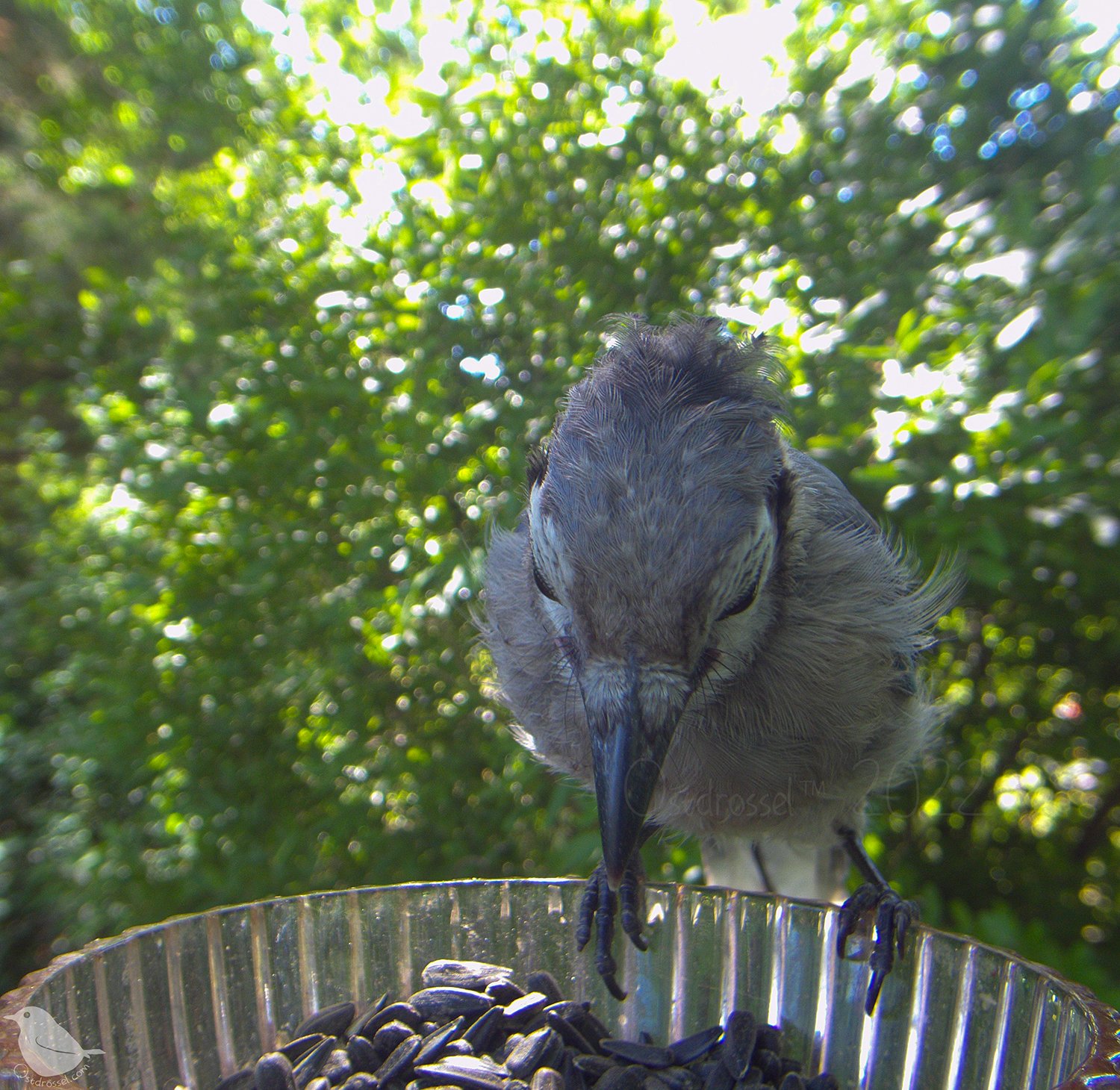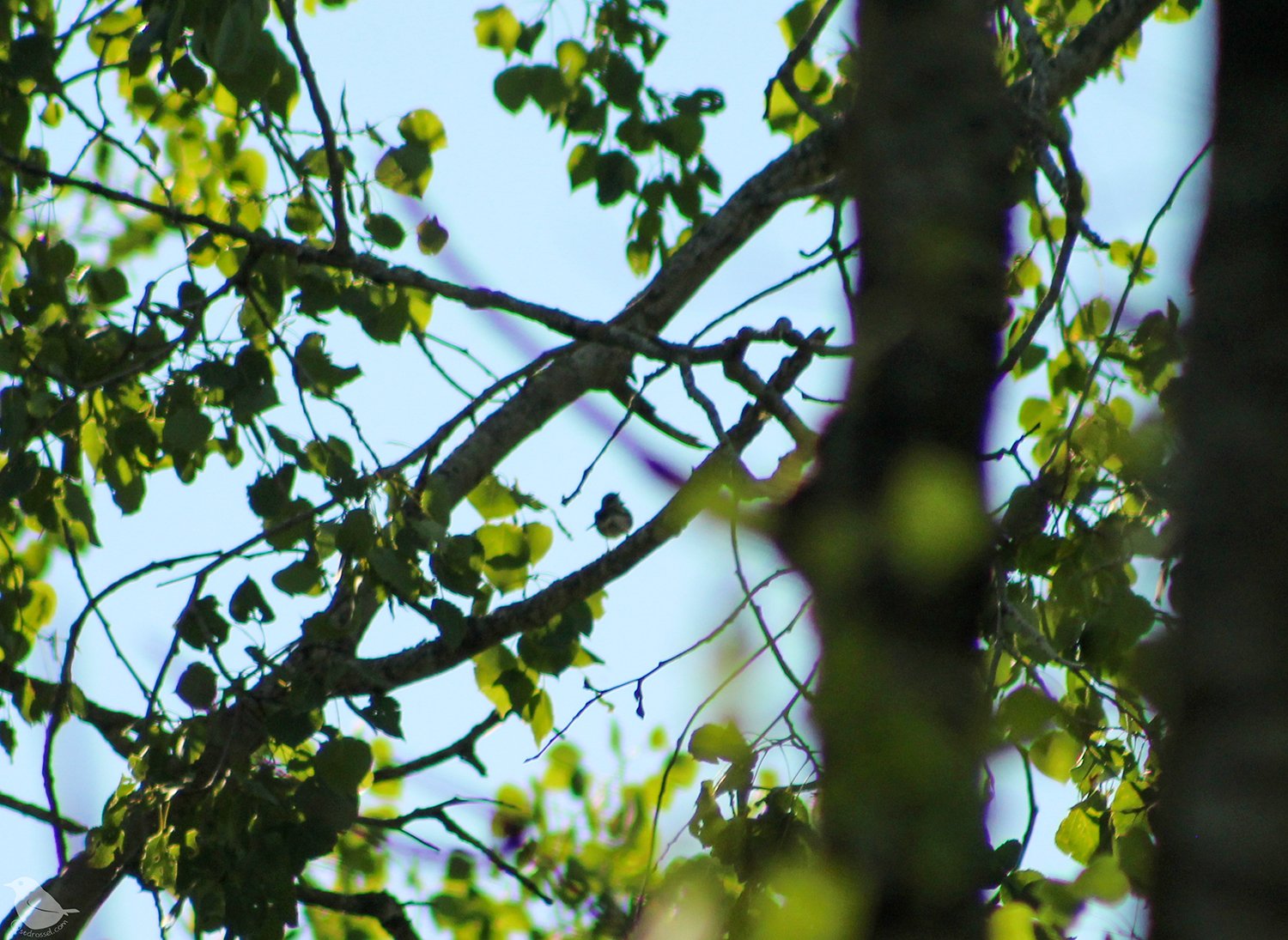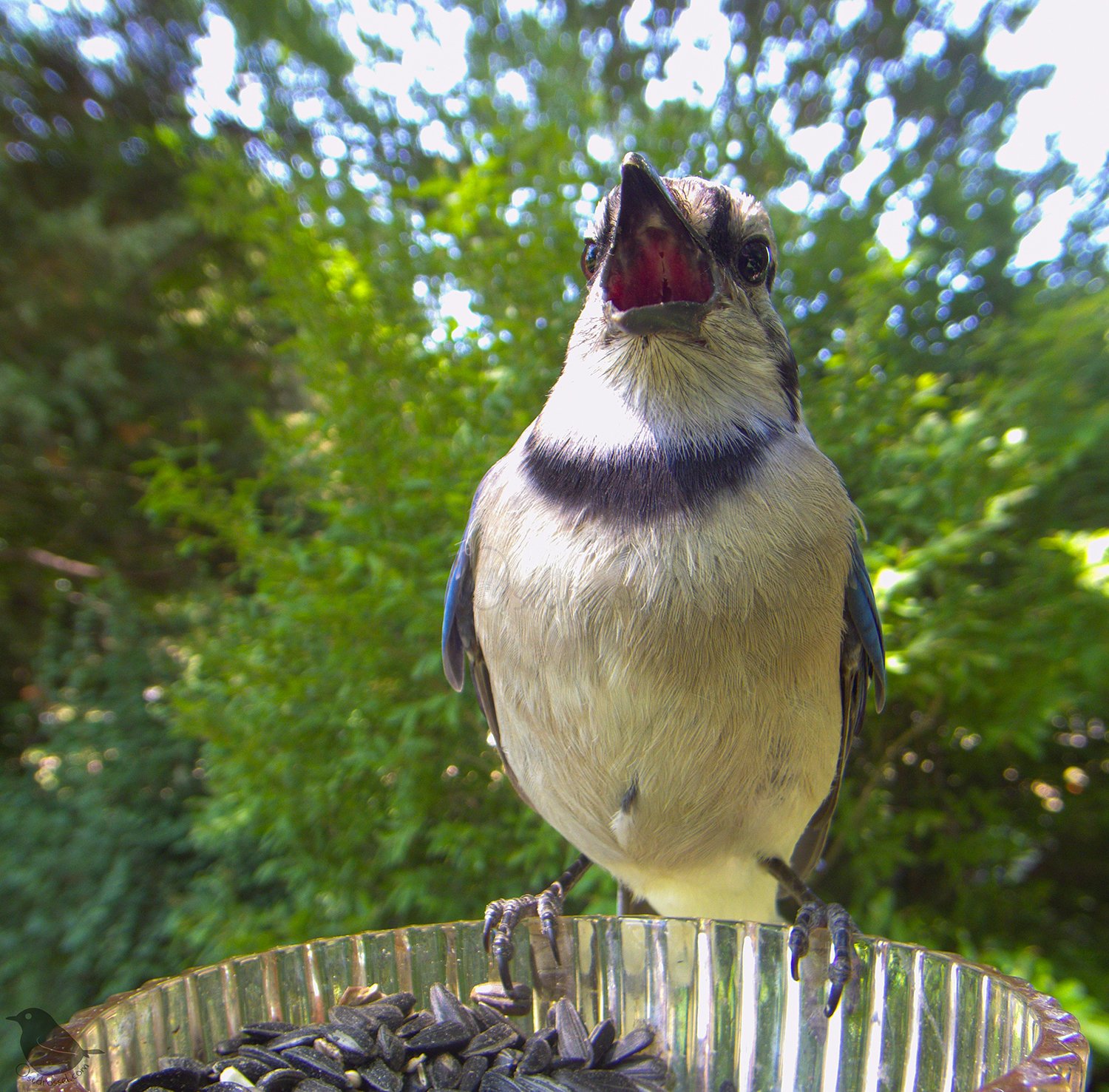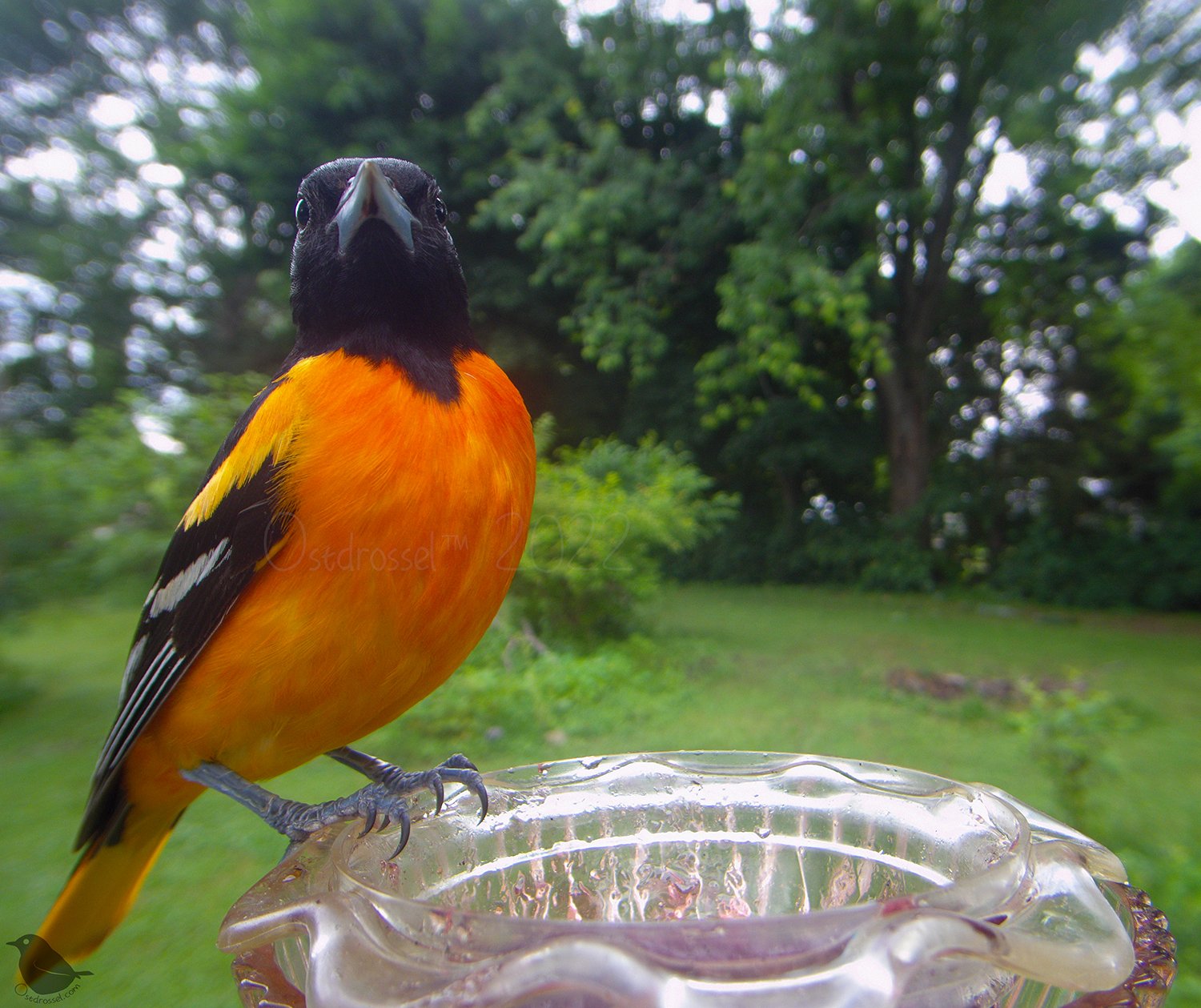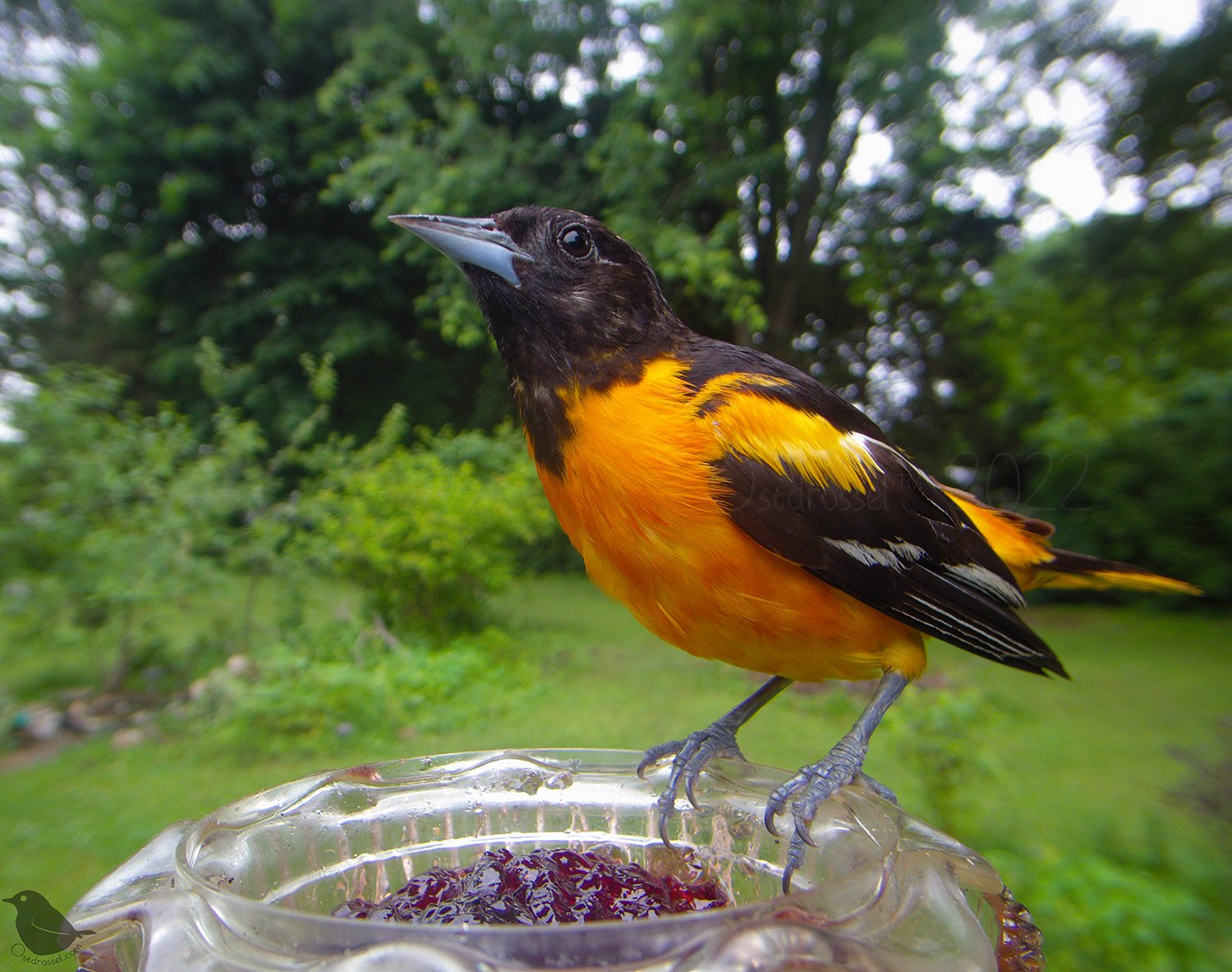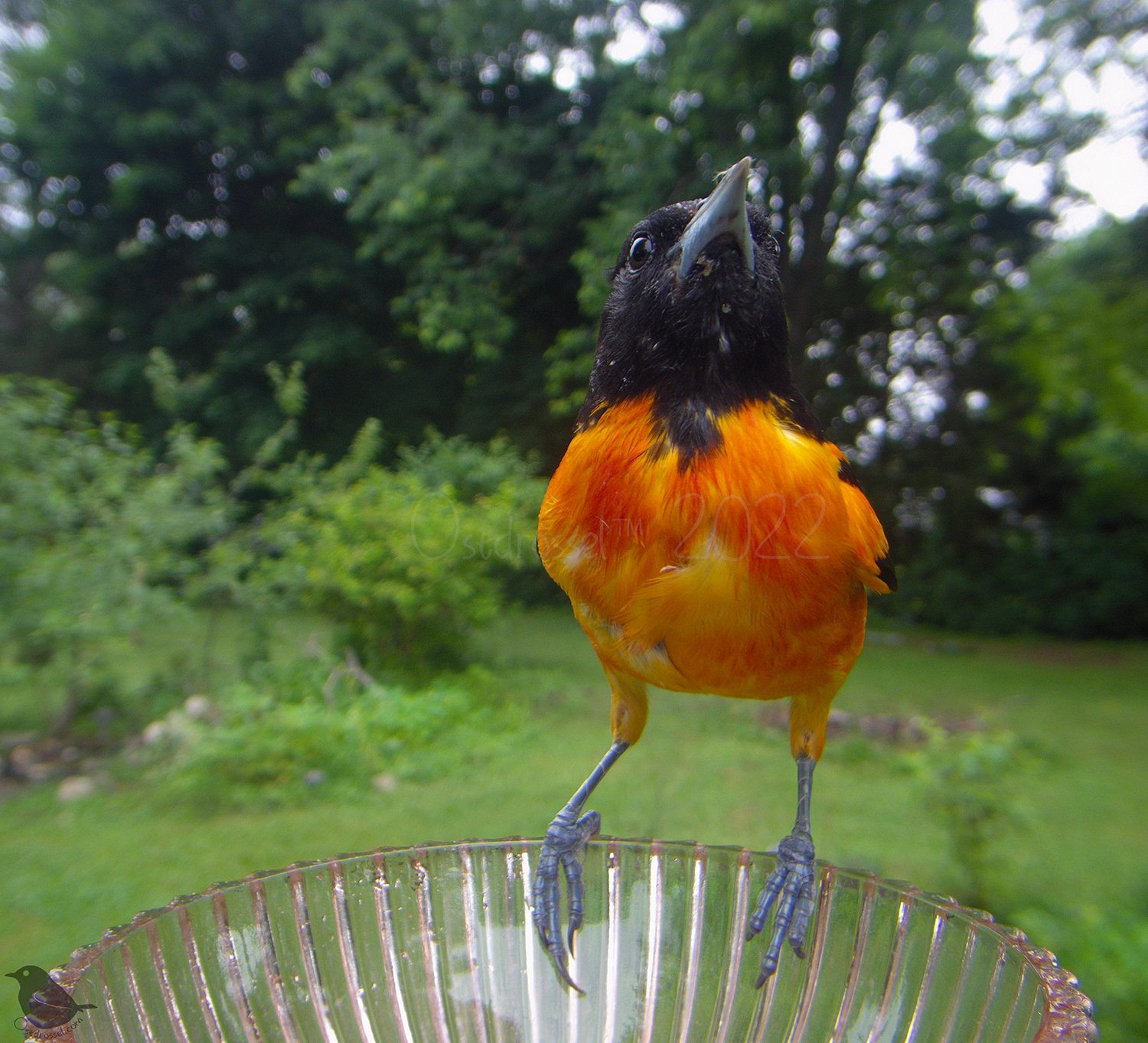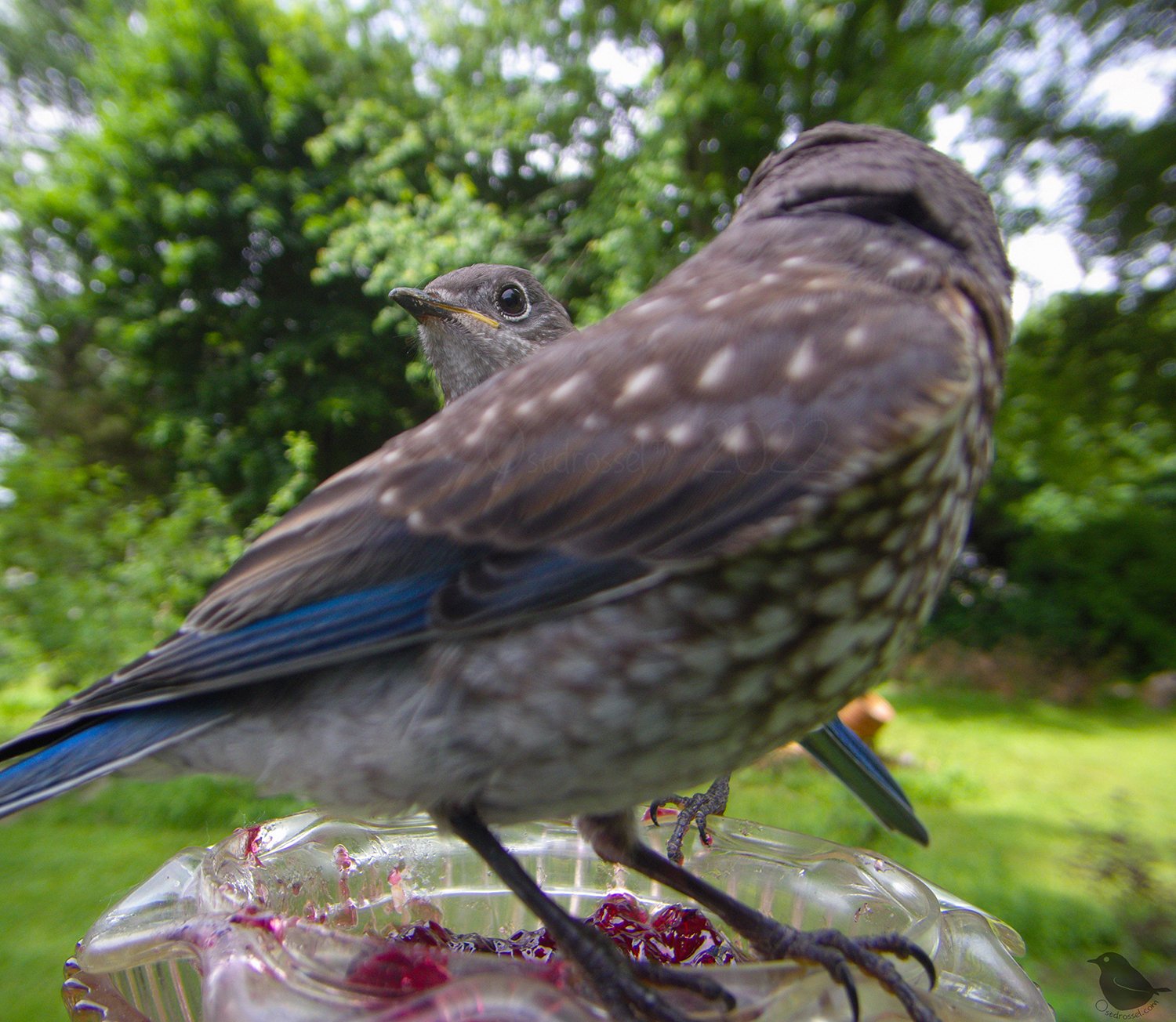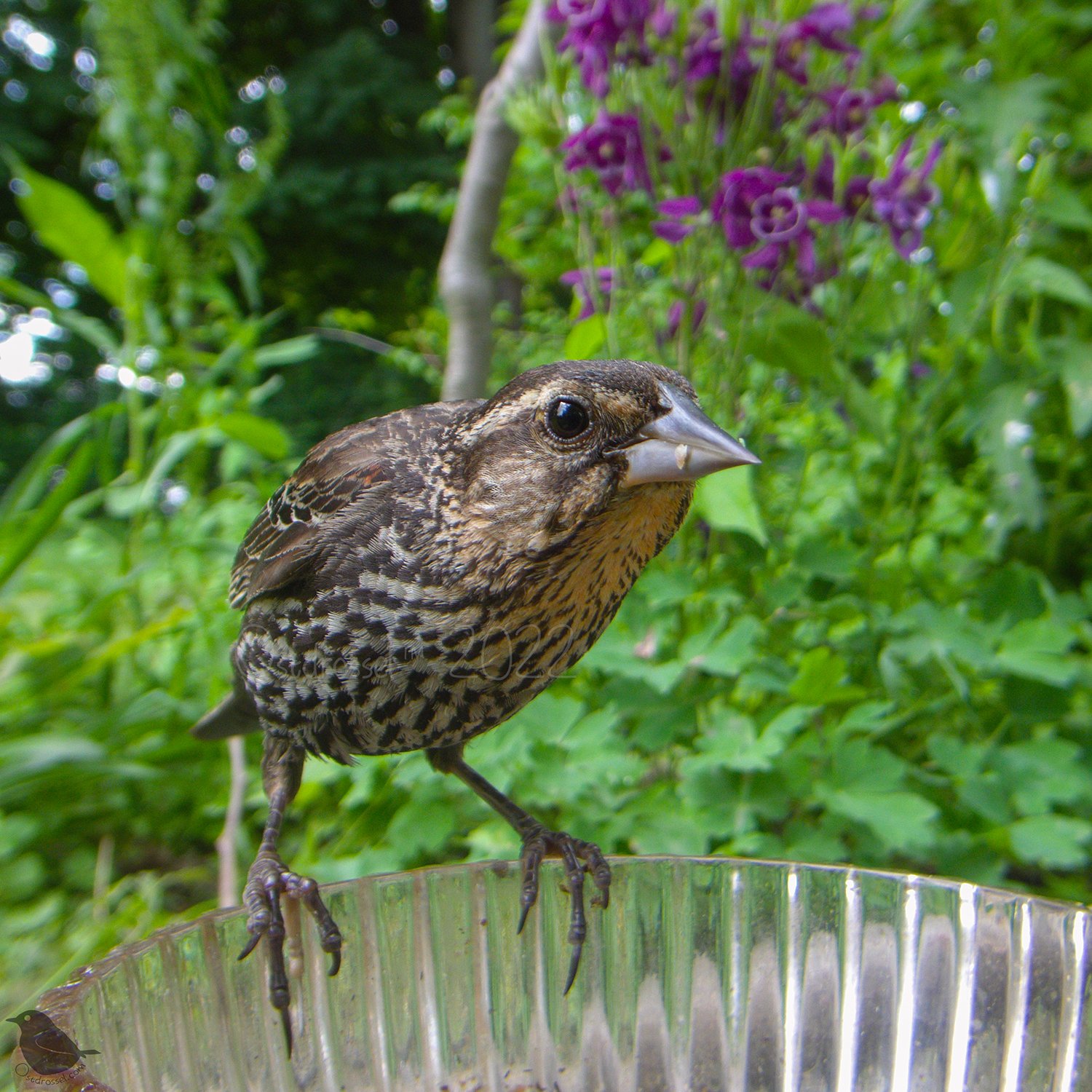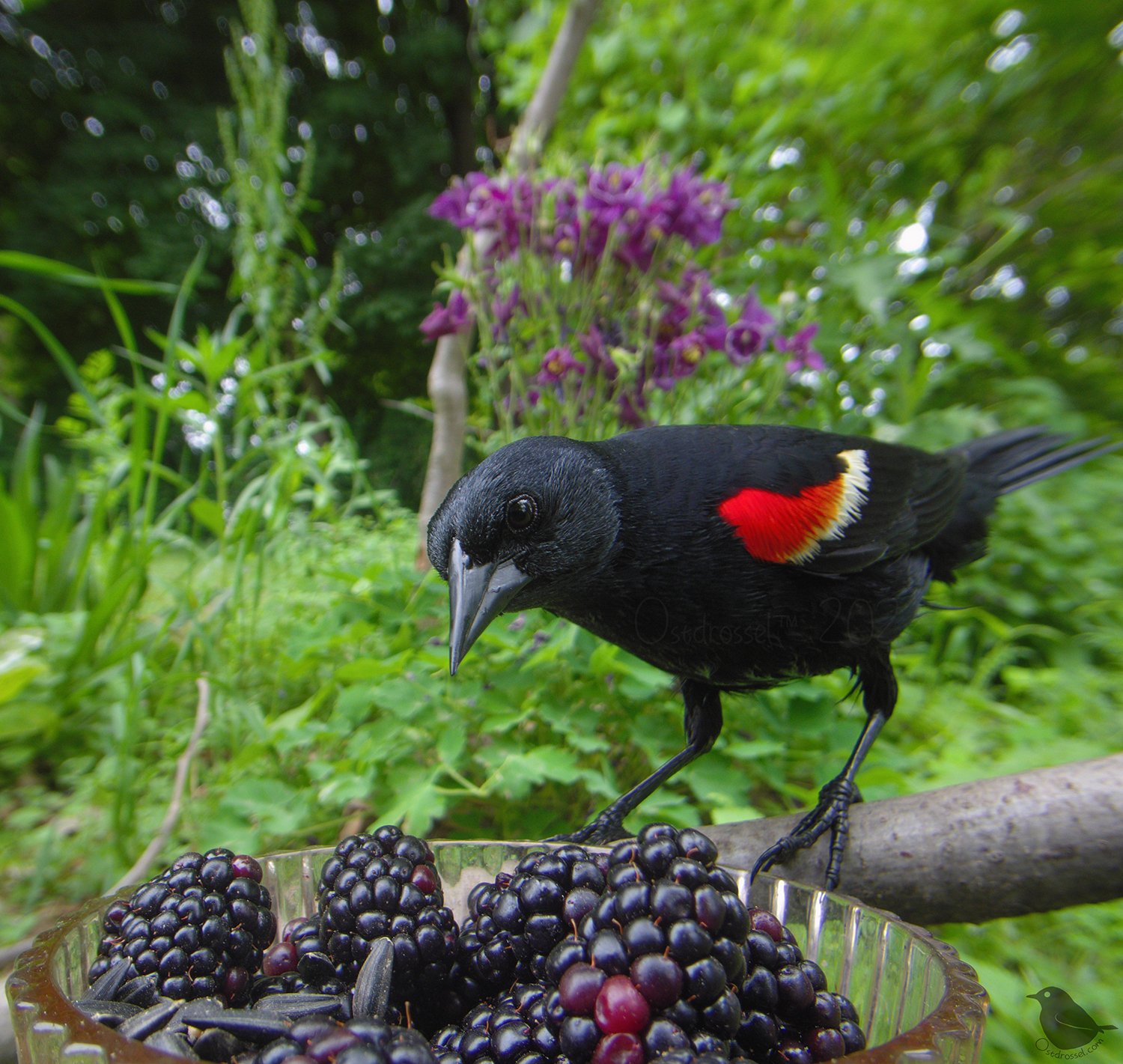As we move farther
into summer, you might also notice birds that look like they are balding. If you are new to this, it might make you think something is wrong with them, but you can calm down. Most of the times, they are in the process of molting. They lose old feathers and grow new ones. What better time to do this than during summer? During that time, they appreciate nutricious food and clean bird baths, because those incoming feathers itch! The most dramatic molds I have seen were with Grackles, Blue Jays and Cardinals. And here is one of the first of 2022 😁 He is just getting started.
Redbellied Woodpeckers
are birds that I see here year-round. I love them for their goofiness and also because they are not feeder-shy. This year, the resident couple has raised one baby, and that baby has now started to come to the cameras too. The male turns into a slobbering mess every summer (he produces a lot of saliva), and molting does not do him any favors either. I think the hole nesting process must be extra hard on him. Did you know that the males actually incubate too with this species? Pretty cool. (male, youngster, female from left to right)
Blue Jays are
one of these birds where seemingly all individuals look pretty much alike. However, that is not true, and since they apparently had a good breeding season, there are lots of babies around right now and it is fun to look at all the different varieties they come in. So many colors, patterns and textures. The youngest ones have slightly curly feathers but the markings in the face can differ regardless of age. The red stuff on some of them is Mulberry juice.
I have been
on a much needed little break from the everyday and my computer and spent the weekend with family in the beautiful north of Michigan. There is an abundance of wildlife there, and lots of birds. I brought my cameras along but the birds there are not used to them and declined to check them out. So I decided to relax and listen. The Merlin app is a great little tool to explore your surroundings in regards to bird song. Here is my list from six minutes yesterday morning, my attempt to take a photo of the Chestnut-sided Warbler, one of the many Cedar Waxwings, and some of the unfeathered creatures. Here’s to a great Monday and week!
And yes, even more baby birds.
I have noticed a lot more Redwinged Blackbirds around this year. I have no idea why but I love that they are not camera shy. Here is a young one, the coloring is much more peach and there is of course the typical baby gape, the rosy beak “corners”.
Baby birds!
In the last couple of days, the air has filled with more squeaks and begging calls. The Blue Jay babies have fledged, as well as Orioles, Redwinged Blackbirds, more Doves and Grackles. Not pictured but also seen were a Redbellied Woodpecker baby and a young Cardinal. All of them also seem to love the pond, so there is lots of fun stuff happening there. It is wonderful to see them explore things and follow the parents around. (Oriole, Mourning Dove, Blue Jay, Grackle, Blue Jay, Redwinged Blackbird)
It has been a strange season
for Hummingbirds this year. They arrived about in time like normal but they have been extremely shy this year so far. Hummingbird activity in my backyard has been constantly decreasing in the last three to four years, and I am not really sure why. It might be the extreme weather they experience on their journey, it might be more flowers around, or more people having feeders out. What I do know is that I miss seeing them more frequently, they are so magical. Here is one that visited yesterday. Come good into Friday.
The Orioles
have been extra busy at the feeders recently, and I am expecting to see their babies in the yard soon. I have already heard their gentle little calls in the trees yesterday. The Orchard Oriole is also still coming, and I am hoping that maybe this year, it might bring a young one to the feeder too. In the meantime, the adults are enjoying the amenities the yard has to offer and make the world prettier with their vibrant colors and songs. Come good into the week!
Baby birds
are adorable not just because of their mostly cute looks but also because of the noises they make and how they behave, especially after they fledged. I have heard baby Orioles yesterday, I heard and saw a glimpse of a baby Blue Jay but other than that, everybody seems to still be in the nest. Except for the Grackles. The parents often “park” them by the pond and go to find food. The babies are playing with things in and around the water, take baths and in between get fed. And some of the more brave ones join the parents at the feeder bowls. They already have the sincere look of the adults but with added cuteness.
The extreme heat
of the last two days has been rough on everybody, including the garden. The bird bath was visited frequently, and during the hottest hours, everybody was looking for shade or ways to stay cool. Some take sunbaths, looking like they have a seizure, others puff up. Apart from the Grackles, the MoDos are my favorite puffer uppers. They always seem very self-confident, and this one is no exception.
Summer is here,
and we are starting it with another really hot day. Temperatures will reach around 36 °C / 98 °F today. I have watered the garden, filled the bird baths and gave the nestboxes some extra shade. The Wren sadly lost two more eggs to that destructive other Wren yesterday, but she seems to be hanging on. (Update on the Wren - the other Wren came and tossed the last remaining egg earlier and is now working on the nest.) The Bluebirds are looking great. And there are many Orioles stopping by. Here is a little selection. Stay cool and hydrated and happy summer solstice!
Life has been busy
and the yard has been a bit quiet because it is nesting season. But here are a couple of the current regulars. The Orioles have started to come back more, even the Orchard Oriole! Some baby Doves are around, Gracks, Grosbeaks, Blue Jays and Robins. The garden is growing, and so are the babies. Happy Sunday!
The backyard is starting to fill
with more baby birds each day, it is the best time of the year. They are following the parents, learning how to find food, get clean and feel safe. Here are members of the thrush family, a young American Robin and two Eastern Bluebirds, all checking out the grape jelly. Funnily enough, the Bluebirds resemble the European Robin, while the American Robin looks a lot like a European Blackbird. Come good into the week!
I haven't posted Blue Jays in a bit,
but they are around, raising babies and also still flirting. There is at times a lot of wailing and begging going on. This one showed off in the bright sunshine. I cannot wait to see the youngsters.
Redwinged Blackbirds are interesting
Redwinged Blackbirds are interesting to me because they are one of the harbingers of spring, they carry the German flag and a Pearl Jam song on their feathers, they have an interesting song and they are feisty when they defend a nest. They are also very beautiful, and the females none less than the males. In recent days, I have seen females a lot all over the yard and feeders, so there were good opportunities to get photos. I love the faint red on their shoulders.
European Starlings are considered invasive
in the US, meaning that they are not a native bird over here. They were supposedly brought to America through a man named Eugene Schieffelin who released a bunch of them in Central Park in 1890 as part of a personal project to bring all birds that have been mentioned in Shakespeare to the New World. Starlings have experienced a success story in the US, much to the detriment of some native species that were not prepared for them. As an invasive species, they are not protected by the Migratory Bird Treaty, so people are allowed to take active measures to control them. Many American bird enthusiasts are not a huge fan of them. However, they are part of the bird world here, they are fascinating in their own right, and I find it important to show them every so often too so people can recognize them and maybe become a bit more aware of their impact. (Plus, they can be entertaining and I also have followers from their native region.) There are lots of ressources about Starlings and the other main invasive bird in the US, the House Sparrow, to be found online. Here is one link with some background in regards to Schieffelin link. For an alternative view, here is another link, it is a complex topic. Without further ado, here is a young European Starling.
I loved the Grack photos so much
that I put a camera on the ground again. And this time, he was less shy. Baby birds always look so cute with their off proportions, different feathers and the vibrantly colored gape, the soft flesh around the beak base. In Grackles, it is pink, Bluebirds have an egg yolky yellow, for example. The vibrant gape is a good marker to identify a baby bird, and it also gives them their pouty appearance. There are actually several young Grackles around, in the second photo you can see that the youngster already starts to get some purple specks on the head too, so he is a bit older.
(Bonus photo of a Red-winged Blackbird is second-to-last.)
We did more gardening this weekend,
also because there isn’t a lot of bird activity going on because everybody is either incubating or taking care of very young babies. For a change, I did put a camera on the ground because I wanted to see if I could get photos of one of the adorable Grackle babies that have started to show up. And I was lucky. As you can see, they are very demanding, but Grackles are excellent parents and will dutifully feed those pink lined beaks. As always when there’s a camera on the ground, some squirrels also came by. This one had such a hilariously smug look on his face that I included him here even if he is out of focus.
In nestbox news, Gayle is incubating her five eggs and learned how to handle the Wren guard, and the Wren has surprisingly laid an egg the other day in the other box. I had kept removing sticks to keep the Wrens busy but they apparently were more determined than I anticipated. She has three eggs as of today. Interfering with an active nest of a native bird is illegal, so they can do their thing now. Hopefully, the Wren guard on the BB box will continue to work and all will be well. The Wren chose the two-holed PVC box with 6 inches in diameter. Since other birds keep exploring that box as well, I have added a hole reducer so that only Wren size can enter. Here’s to a good week!
The BB babies
are now confident enough to fly around the yard by themselves and also visit the feeders. There is at least one male (you can tell by him already having more blue feathers than the girls). Gayle has laid her fourth egg today, and so far, the Wren guard seems to work too. The next couple of weeks will be fun with loads of babies coming to the backyard.









